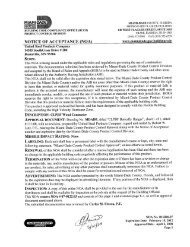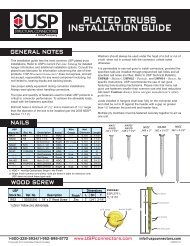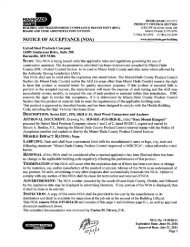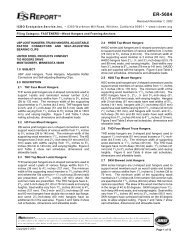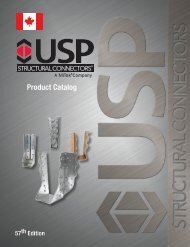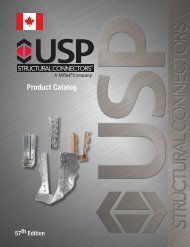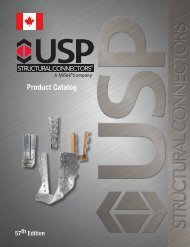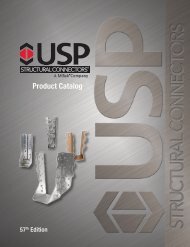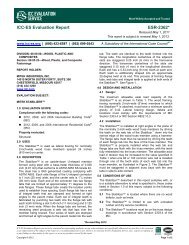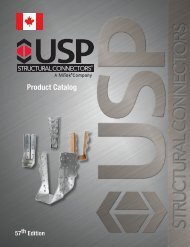EWP Hangers - USP Connectors
EWP Hangers - USP Connectors
EWP Hangers - USP Connectors
You also want an ePaper? Increase the reach of your titles
YUMPU automatically turns print PDFs into web optimized ePapers that Google loves.
Wood I-Joist Installation to Wood<br />
<strong>EWP</strong> <strong>Hangers</strong><br />
Sloped I-Joists<br />
Use sloped seat hangers and beveled web stiffeners<br />
whenever the slope exceeds the following: 1/2:12 for seat<br />
bearing lengths of 21/2˝ or less; 3/8:12 for bearing lengths<br />
between 21/2˝ and 31/2˝; and 1/4:12 for bearing lengths in<br />
excess of 31/2˝.<br />
Multiple I-Joist Plies<br />
Fasten together multiple plies of wood I-Joists, in<br />
accordance with the manufacturer’s installation guidelines, such<br />
that the joists act as a single unit.<br />
I-Joist Rotation<br />
It may be necessary to install straps, blocking, or sheathing to<br />
restrain torsional rotation of a supporting wood I-Joist when<br />
using top mount I-Joist hangers.<br />
Fasteners<br />
Install only the specified nails. The flanges of wood<br />
I-Joists may split if larger diameter nails or longer nails are<br />
installed. Do not install nails larger than 16d common wire nails<br />
(0.162˝ diameter) into the web stiffeners in the wood I-Joist.<br />
Backer Blocks<br />
Pattern the nails used to install backer blocks or web<br />
stiffeners in wood I-Joists to avoid splitting the block. The nail<br />
pattern should be sufficiently spaced to avoid the same grain<br />
line, particularly with solid sawn backer blocks. Backer blocks<br />
must be installed on wood I-Joist acting as the header, or<br />
supporting member. Install in accordance with the I-Joist<br />
manufacturer’s installation guidelines. The nails used to<br />
install hangers mounted to an I-Joist header must penetrate<br />
through the web and into the backer block on the opposite<br />
side.<br />
Top Flange <strong>Hangers</strong><br />
The thickness of the hanger metal and nail heads on top mount hangers must be evaluated for the effect on<br />
subsequent sheathing. Ensure that the top mount hanger is installed so the flanges of the hanger are not<br />
over-spread which tends to elevate the supported I-Joist causing uneven floor surfaces and squeaking. Similarly, ensure that<br />
the hanger is installed plumb such that the face flanges of the hanger are mounted firmly against the<br />
wide-face surface of the header.<br />
© Copyright 2013 <strong>USP</strong> Structural <strong>Connectors</strong> ®<br />
Flush framing ! Hanger over-spread ! Hanger not plumb<br />
Correct Slant Nail Installation<br />
Always secure<br />
wood I-Joist using<br />
10d x 1 1 ⁄ 2˝<br />
nail driven at a<br />
30° to 45° angle<br />
and firmly seated<br />
!<br />
!<br />
Common Nailing Errors<br />
Wrong Angle<br />
When a nail is driven into the bottom flange of the wood<br />
I-Joist parallel to the glue lines, separation of veneers can<br />
occur which substantially reduces the design loads of the<br />
connection.<br />
Nail Too Long<br />
When using nails longer than <strong>USP</strong>’s recommended nails,<br />
bottom flange splitting may occur. Also, this can raise the<br />
wood I-Joist off the seat, resulting in uneven surfaces and<br />
squeaky floors along with reduced factored resistance.<br />
116<br />
1-800-328-5934 • www.<strong>USP</strong>connectors.com



